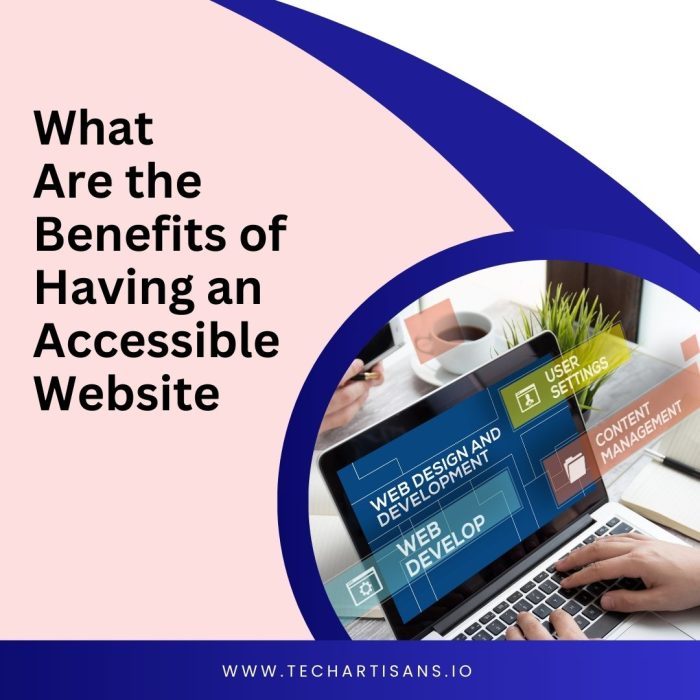In today’s online world, making websites accessible is crucial for businesses. Following WCAG rules makes sure everyone can use your site, helping your business grow. It’s not just the right thing to do; it’s also smart for staying ahead in the online competition. Make your website accessible to unleash its full power.
What Are the Benefits of Having an Accessible Website
Discover how web accessibility can stimulate growth, expand reach, and foster inclusivity for your business. Let’s explore the benefits of having an accessible website.
Enhanced User Experience
An accessible website isn’t just beneficial to users with disabilities; it offers an enhanced user experience for all visitors. Let’s explore how prioritizing web accessibility can significantly improve overall user engagement and satisfaction on your business website.
Improving Usability for All Visitors
Web accessibility means easy navigation and clear content for all users. User-friendly sites lead to longer visits and higher conversion rates. WCAG compliance also enhances SEO, as structured design and alt text improve search engine visibility. Prioritize accessibility for a seamless, engaging online experience that benefits everyone.
Case Studies of Improved User Satisfaction
Imagine a mid-size online store embracing WCAG guidelines and witnessing a 30% boost in user engagement and a 20% rise in sales in just six months. Similarly, a local news website’s accessibility efforts led to lower bounce rates and more returning users, highlighting the link between web accessibility, user satisfaction, and business success.
SEO Advantages
Web accessibility not only caters to a wider audience but also imparts a significant advantage on the search engine optimization (SEO) front. Let’s delve deeper into how making your website accessible can help improve its visibility on search engine results pages.
How Web Accessibility Impacts SEO
Web accessibility and SEO share a common goal – to make content understandable and accessible for all, including search engines. A website that adheres to WCAG guidelines tends to have a clear structure and layout, making it easier for search engine crawlers to index the site effectively. This enhances the website’s visibility in search engine results, leading to an increased organic traffic flow.
Practical Tips for Improving SEO Through Accessibility
The first step towards improving SEO through web accessibility is by structuring your content with clear headings and subheadings. Next, use descriptive link texts and alt tags for images, enhancing their discoverability by search engine bots. Finally, ensure your website has a responsive design to accommodate various devices and screen sizes.
Expanded Market Reach
Web accessibility is a powerful tool for expanding your market reach. By creating an accessible website, you’re unlocking the potential to engage with a broader audience, including those with disabilities and the aging population.
Broadening Your Audience to Include Users With Disabilities
Ensuring web accessibility isn’t just an ethical duty, but a smart business move. It opens doors to an underserved market of users with disabilities who value inclusive platforms. By prioritizing accessibility, you can expand your customer base, potentially boosting sales and loyalty.
The Economic Power of the Disability Market
The disability market is a vast, underserved demographic, with over a billion people and significant purchasing power. By embracing web accessibility, businesses can access this market, expanding their customer base and revenue potential.
Competitive Advantage
Adhering to WCAG and prioritizing web accessibility can also provide your business with a distinct competitive advantage in today’s digital marketplace. Let’s explore how an accessible website can set you apart from your competitors and help you gain a larger market share.
Gaining an Edge Over Competitors
In the digital landscape, businesses often struggle to differentiate themselves from their competitors. By implementing WCAG and prioritizing web accessibility, your business can carve out a unique selling proposition. Not all businesses cater to the needs of individuals with disabilities, so having a website that is fully accessible can make your business stand out, attracting a broader audience and creating a positive brand image.
Public Relations Benefits of an Accessible Website
Having an accessible website not only supports your brand’s image as socially responsible but also generates positive public relations. Highlighting your commitment to inclusivity and accessibility can garner media attention, enhance your reputation among consumers and within your industry, and attract the interest of potential partners and investors.
Technical and Operational Benefits
Ensuring web accessibility also yields several technical and operational advantages, streamlining operations and fostering a more efficient digital presence. Let’s delve into how embracing WCAG and prioritizing web accessibility can enhance your website’s technical performance and operational efficiency.
Improved Mobile Usability and Responsive Design
Web accessibility guidelines, like WCAG, emphasize responsive design for better mobile usability. A responsive design ensures your website works well on all devices, including smartphones and tablets. This is essential due to the significant mobile user traffic, improving the overall user experience and SEO rankings.
Site Speed and Maintenance Efficiencies
Prioritizing web accessibility, and following WCAG guidelines, can lead to faster website load times. Accessible sites are well-structured and load quickly even on slower connections, enhancing user experience and engagement. Accessibility also simplifies maintenance and updates, saving time and resources. This ensures operational efficiencies and a smoother digital experience for all users.
Risk Management
In an era of growing digital dependence, risk management is a crucial aspect of running a successful online business. Let’s shed light on how making your website accessible correlates with effective risk management, especially in terms of legal implications and reputation management.
Reducing the Risk of Legal Action
In many regions, including the United States and the European Union, web accessibility is not merely a recommendation, but a legal requirement. Non-compliance can result in legal action, costly penalties, and negative publicity. By adhering to WCAG and ensuring your website is accessible, you can significantly mitigate these legal risks and potential financial losses.
Building a Proactive Accessibility Policy
Formulating a proactive web accessibility policy involves anticipating and addressing accessibility needs even before they arise. This forward-thinking approach not only fulfills WCAG criteria but also demonstrates your commitment to inclusivity. It enhances user experience, safeguards against legal risks, and strengthens your brand’s reputation for social responsibility.
Social Responsibility and Brand Image
In an era where businesses are increasingly expected to contribute positively to society, embracing web accessibility can significantly bolster your brand’s image as a socially responsible entity. Let’s delve into how prioritizing web accessibility aligns with social responsibility and enhances your brand image.
CSR and Brand Image
Embracing web accessibility as a part of your corporate social responsibility (CSR) initiatives can profoundly influence your brand image. CSR is seen as an indication of your business’s ethical conduct and commitment to society. By ensuring your website is accessible to all, you portray your brand as inclusive and respectful of individual needs.
Case Examples of Brands Leading with Accessibility
Several leading brands have prioritized web accessibility. Microsoft, for instance, has developed inclusive technologies like the Eye Control feature in Windows 10 to aid those with mobility disabilities. Similarly, Google has integrated Live Transcribe and Sound Amplifier into Android, catering to individuals with hearing impairments.
Legal and Ethical Considerations
While making your website WCAG compliant may seem like a technical task, it’s also deeply rooted in ethical business practices and, in many jurisdictions, legal requirements. Let’s understand why web accessibility is not just a good-to-have, but a must-have in today’s digital era.
Avoiding Discrimination and Legal Complications
Web accessibility is more than compliance; it’s about preventing discrimination. An inaccessible website can exclude users with disabilities, harming your brand’s image and risking legal issues. Laws like the ADA now cover digital accessibility, and non-compliance can lead to lawsuits. Complying with WCAG safeguards your business and promotes inclusivity.
ADA and Global Accessibility Standards
The ADA and global standards like WCAG mandate accessible digital spaces. These guidelines prioritize equality and accessibility for everyone. Adhering to them is ethical and a smart business strategy.
Conclusion
Web accessibility is both ethical and strategic, offering operational efficiency, risk management, and a stronger brand image. By following WCAG guidelines, you enhance mobile usability, meet legal requirements, and create a more inclusive digital presence. It’s a win-win for businesses of all sizes, signaling your commitment to inclusivity in the digital world. Embrace accessibility to stand out in the digital landscape.







